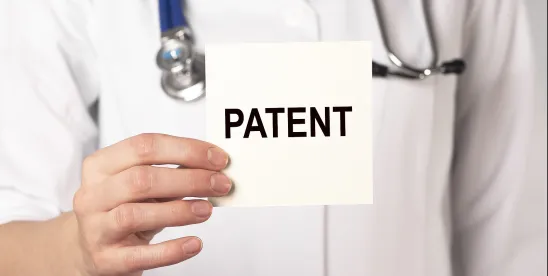This Federal Circuit opinion analyzes various key issues in patent litigation, including the role of applicant admitted prior art (“AAPA”), standing, and obviousness.
Background
Shockwave Medical, Inc. (“Shockwave”) owns U.S. Patent No. 8,956,371 (“the ’371 patent”). This patent is directed to the treatment of atherosclerosis through intravascular lithotripsy (“IVL”). The patent describes a shockwave balloon catheter system used in angioplasty procedures to break up calcified plaque in blood vessels with mechanical shockwaves, rather than solely relying on balloon inflation pressure. The claimed device combines a standard over-the-wire balloon catheter with electrodes and a pulse generator. When activated, the electrodes inside the fluid-filled balloon generate electrical arcs, producing shockwaves that travel through the fluid and the balloon to fracture hardened plaque with minimal vessel wall trauma.
In December 2018, Cardiovascular Systems, Inc. (“CSI”) filed an inter partes review petition challenging all 17 claims of the ’371 patent as obvious over various prior art references, including European Patent Application Publication No. EP 0571306 A1 (“Levy”), which describes using laser generated pulses to disintegrate plaque in blood vessels, and the AAPA’s description of conventional over-the-wire balloon catheters. CSI’s proffered prior art combinations involved Levy as modified by the AAPA in combination with other prior art references.
In July 2020, the Patent Trial and Appeal Board issued a Final Written Decision finding claims 1–4 and 6–17 unpatentable as obvious, but held that CSI had not proven claim 5 was unpatentable. The Board initially treated the AAPA as “prior art consisting of patents or printed publications” under 35 U.S.C. § 311(b). However, following subsequent guidance from the U.S. Patent and Trademark Office stating that AAPA is not “prior art consisting of patents or printed publications” under § 311(b), the Board reheard the matter. On rehearing, the Board relied on the AAPA only as evidence of background knowledge, but still reaffirmed its previous findings that claims 1–4 and 6–17 were unpatentable as obvious, while upholding claim 5.
Shockwave appealed the Board’s decision as to claims 1–4 and 6–17, and CSI cross-appealed as to claim 5. The issues involved in Shockwave’s appeal relate to AAPA, claim construction, and the Board’s factual findings. The issues involved in CSI’s cross-appeal relate to standing and obviousness.
Issues
- Did CSI in its petition and the Board in its final written decision improperly rely on AAPA as a basis for the obviousness grounds, in violation of 35 U.S.C. § 311(b)?
- Did the Board err in rejecting Shockwave’s proposed construction of “angioplasty balloon” and instead adopting CSI’s broader construction of the term?
- Were the Board’s factual findings regarding the disclosures of the Levy reference, the motivation to combine, and the weight of Shockwave’s secondary considerations evidence supported by substantial evidence?
- Does CSI have Article III standing to pursue its cross-appeal in the Federal Circuit?
- If CSI has standing, did the Board err by failing to properly consider the combined teachings of the prior art in finding claim 5 not unpatentable as obvious?
Holdings
- The Board and CSI did not improperly rely on AAPA as a basis for the obviousness grounds in violation of 35 U.S.C. § 311(b); AAPA was used only as evidence of background knowledge.
- The Board did not err in rejecting Shockwave’s proposed construction and properly adopted CSI’s broader construction of “angioplasty balloon”.
- The Board’s factual findings regarding the Levy reference, the motivation to combine, and secondary considerations were supported by substantial evidence.
- CSI has Article III standing to pursue its cross-appeal in the Federal Circuit.
- The Board erred by failing to properly consider the combined teachings of the prior art in finding claim 5 not unpatentable as obvious.
Reasoning
- AAPA. The Federal Circuit reasoned that while IPR petitions must be based on patents or printed publications under 35 U.S.C. § 311(b), AAPA can still be used as evidence of general knowledge in the field. The Federal Circuit observed that CSI used AAPA only to demonstrate that over-the-wire balloon catheters were well known—a fact acknowledged by the challenged patent itself—and merely to supply claim limitations that were not novel, not as a statutory basis for unpatentability. Unlike prior IPRs, CSI’s petition did not designate the AAPA as an explicit ground for obviousness.
- Construction of “Angioplasty Balloon”. The Federal Circuit weighed Shockwave’s proposed construction of “angioplasty balloon” (i.e., “a balloon that displaces the plaque into the vessel wall to expand the lumen of the vessel”) against CSI’s broader construction (i.e., “an inflatable sac that is configured to be inserted into a blood vessel for use in a medical procedure to widen narrowed or obstructed blood vessels”). The Federal Circuit found nothing in the claims or specification supporting a requirement that the balloon must displace plaque into the vessel wall. Instead, the specification makes clear that while the balloon can fit snugly to the vessel wall, this is not required, and further describes embodiments where plaque is broken up by shockwaves without excessive pressure from the balloon. Based on this understanding, the Federal Circuit concluded the Board correctly adopted CSI’s broader construction.
- Board’s Factual Findings. The Federal Circuit found that substantial evidence supported each of the Board’s challenged factual findings. First, the Board properly found motivation to combine Levy’s shockwave system with an over-the-wire balloon catheter, supported by expert testimony and reasons such as improved navigation and expanded treatment options. Second, regarding whether Levy discloses the use of shockwaves in blood vessels, the Federal Circuit agreed with the Board that Levy incorporates by reference an earlier patent (Levy ’227) that teaches shockwaves produced by laser pulses can be used for cleaning both tooth canals and blood vessels, and also noted that other prior art references taught the use of arc generators to achieve the claimed shockwaves. Third, on secondary considerations, the Federal Circuit concluded that the Board did not err in finding Shockwave was not entitled to a presumption of nexus between the claimed invention and objective evidence of non-obviousness, because Shockwave’s expert failed to adequately link the product to the claims, and that the Board appropriately found the secondary considerations evidence weak and not probative of non-obviousness.
- CSI’s Standing. The Federal Circuit reasoned that CSI had an IVL device in its final stages of development, including an impending design freeze and upcoming clinical trials. The Federal Circuit also considered Shockwave’s public statements about aggressively enforcing claim 5 against competitors. While such statements do not always create litigation risk, here, the combination of CSI’s concrete product development and Shockwave’s enforcement posture created a substantial risk of suit, satisfying Article III’s standing requirement.
- Claim 5’s Obviousness Analysis. The Federal Circuit reasoned that the Board erred in its analysis of claim 5 by failing to consider the combined teachings of the prior art as a whole. Instead of evaluating the Uchiyama reference in isolation, the Board should have analyzed Uchiyama together with Levy as modified by the AAPA, as required by the obviousness inquiry. The Federal Circuit held that, when viewed together, the prior art references would have taught an ordinarily skilled artisan to place the electrodes “adjacent to and outside of the guide wire lumen,” as recited in claim 5. The Federal Circuit also noted that Shockwave did not rebut CSI’s supporting expert testimony.
Conclusion
The Federal Circuit (i) affirmed the Board’s determination that claims 1–4 and 6–17 of the ’371 patent are unpatentable as obvious, thus denying Shockwave’s appeal, and (ii) reversed the Board’s determination upholding claim 5, holding that claim 5 is also unpatentable as obvious, thus granting CSI’s cross-appeal.



 />i
/>i

